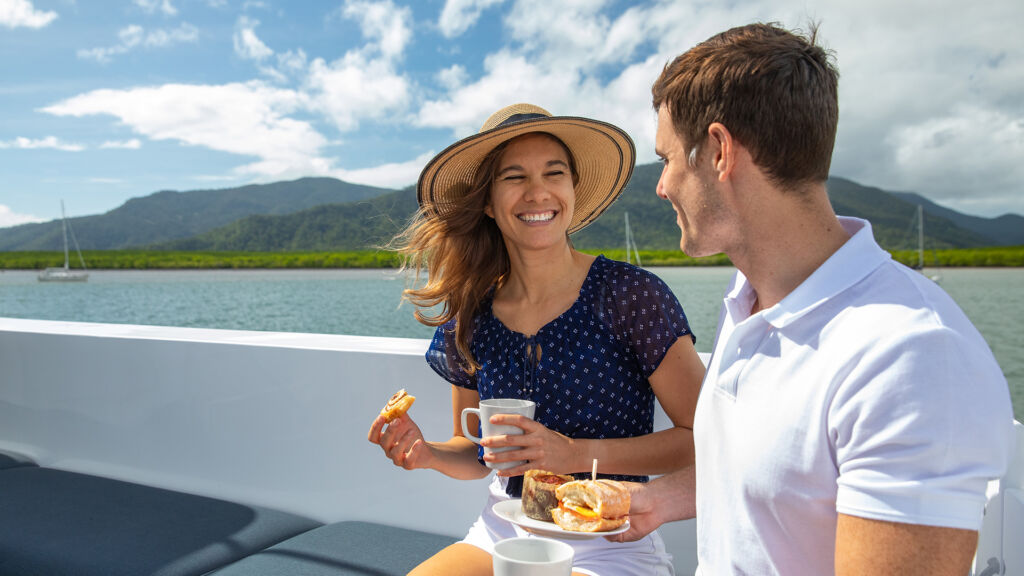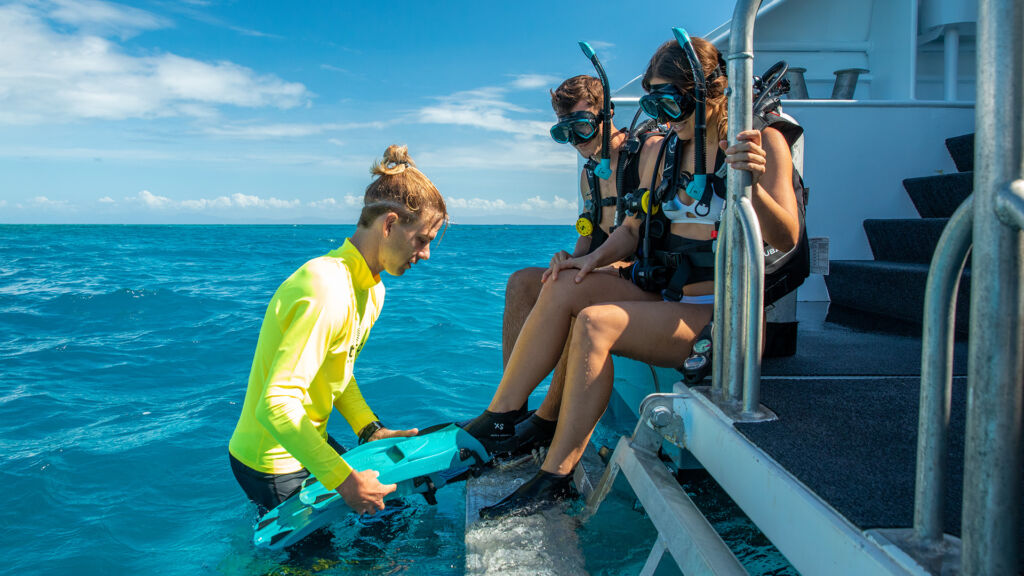FAQs
Our helpful reservations team is happy to help with any questions you might have about our snorkelling and diving day trips, however, check these frequently asked questions first, as we may already have the answer you are looking for!
General FAQs
All our day trips visit the Outer Great Barrier Reef. The outer reefs are the sections furthest from the coast.
These reefs have fewer crowds and benefit from flowing nutrients distributed by the vast Coral Sea. Here, good climate conditions and clear water bring out the best in the coral colours and the incredibly diverse marine life.
With more than 27 sites to choose from, Tusa Reef Tours has the most choice of outer reef locations of all the local operators. On our day trips, we visit two sites per day, based on weather and visibility conditions, to ensure you have the best possible dive or snorkel experience.
The Great Barrier Reef is home to a huge range of marine life. During your day trip, you’re likely to see colourful corals and a variety of tropical and pelagic (ocean) fish – plus sharks, rays, turtles and more! Find out more about the reef here.
As long as you’re comfortable in the water, you should be able to snorkel or even do an intro dive. Before you enter the water you will fill out a form that includes information on your level of competence in the water and any medical conditions. Depending on your response, we may require that you use a flotation device while snorkelling.
Our friendly instructors will talk you through using all the equipment. If you’re unsure, feel free to contact us to discuss.
Some medical conditions can prevent you from scuba diving. Please read our Can I Dive? page carefully and contact us if you have any questions.
You will also be asked to fill out an assessment form before snorkelling. If you are assessed as an at-risk snorkeller you may be required to wear a flotation device while snorkelling.
Yes! For our day trips, you’ll be travelling on the same vessel as all our other passengers – so if you or your travel partners are certified divers and others in your group are not, you’ll share your journey out on the reef together and complete your dives/snorkel experiences at the same sites.
Absolutely, we can accommodate people who don’t wish to snorkel or dive. Each of our vessels has outdoor viewing decks and air-conditioned spaces indoors.
Our chefs serve a variety of high-quality healthy dishes throughout the day. You can view a sample menu of the food we serve onboard here.
You will find a mix of international influences in the meal selection that caters to almost every taste. If you have a special dietary request, please be sure to note this when booking, so that our chefs can be prepared it before departure in the event you require a special meal.
Our vessel is a large catamaran, which offers greater stability and a smoother ride than monohull vessels.
If you are prone to motion sickness, we recommend taking advantage of the natural ginger tablets available onboard for no extra cost. We also have some Travacalm travel sickness tablets available for purchase on board.
Box jellyfish, also known as ‘stingers’, are pale blue, transparent jellyfish. They can measure up to 20 cm along each side of their cube-shaped bodies, and their tentacles can reach up to 3 metres long. Their sting can be very painful, and even fatal in some cases.
Box jellyfish live in the warmer coastal areas sheltered by the Great Barrier Reef, and are most numerous between November and May. We provide protective lycra suits during these months to protect all snorkellers and divers.
It is recommended (but not limited to) that you bring the following items on board:
- Personal items (phone, camera, dive certification if required)
- Swimwear
- Sunhat
- Quick-dry towel or chamois for the dive deck
Tusa Reef Tours can accommodate a maximum of 40 guests and operates with a minimum of 9 crew members.
The dress code recommended onboard is casual attire. For safety and comfort we encourage shoes not to be worn on board.
Smoking is not allowed inside the vessel or on the dive deck. However, there is a designated outdoor smoking area on the sundeck.
If you have additional luggage that you wish to have stored whilst you are out with Tusa Reef Tours, we have storage facilities at our office at no extra cost. Simply advise the driver when they pick you up from your hotel and they will label your luggage for you. They will return your luggage to you when you return to Cairns.
Please note that while all due care is taken to securely store your luggage, Tusa Reef Tours does not accept responsibility for theft, loss, or damage.
There is no maximum age on board Tusa Reef Tours, and if you are fit and healthy to dive, we’d love to have you join us. For guests over the age of 65, a current dive medical is requested for your own safety and for our duty of care.
Our minimum age on board Tusa Reef Tours is 12 years. All guests under the age of 18 must be accompanied by a parent or guardian at all times, including when diving or snorkelling. We cannot guarantee that a crew member will be available to dive with a Junior open-water diver (limited to 12m depth) on all dives.
Your trip price includes everything except any courses taken on board, seasickness tablets, and any souvenirs purchased.
Diving FAQs
Diving the Great Barrier Reef is great year-round! During Cairns’ winter (May to August) the water is a little cooler and offers great visibility and beautiful clear days, but sometimes can bring stronger winds.
From September through December the water warms up a little, and generally, conditions are clear with light winds. Many coral reef species breed at this time.
January through April is considered our wetter season, with amazing feeding and marine action following the breeding season.
We strongly recommend travel insurance to cover you if your snorkel or dive trip is cancelled due to illness, poor weather, travel delays, lost luggage and legal costs. Travel insurance may not cover diving accidents and/or treatment/evacuation. For that we recommend separate insurance – see our Dive Insurance page for more information.
All equipment is included in the trip cost. For a certified diver, this includes a regulator with a console computer, buoyancy control device (BCD), snorkel, mask, fins, wetsuit, emergency signalling devices, tank and weights/weight belt.
The maximum depth for recreational diving is 18m if you hold the standard PADI Open Water Diver Certification (or equivalent), and 30m if you hold the PADI Advanced Open Water certification (or equivalent).
Some of the best dives on the Great Barrier Reef can be done in less than 15m of water, where stronger light can result in an even better view of the abundant marine life.
All divers are asked to complete a medical questionnaire on board. You don’t require a medical if you answer no to everything. If you answer yes to any questions, a further medical may be required. You will also be asked to fill out a general disclaimer which differs from company to company. See our Can I Dive page for more information.
You’ll need to bring your certification card. If you have lost your card, please contact the issuing agency.
Certified divers should bring their logbooks to log their dives on board the vessel, and so our dive supervisors can assess their experience.
In most cases it is, but please contact us so we can be sure. Let us know your certifying agency, certification level and approximate number of dives.
Whenever possible, the Dive Supervisor will buddy you with someone of equal experience.
We do not currently allow freediving with the use of weight belts on any of our boats, due to the risks involved.
Duck diving while snorkelling is allowed but we do not encourage hyperventilation or other breath-hold techniques.
Regulations state that for a single, no decompression dive, you should not fly or go to altitude for at least 12 hours. For multiple dives you should not fly or go to altitude for at least 18 hours.
We recommend waiting at least 24 hours after diving before going to altitude or flying. These are guidelines only – there is no guarantee that following these recommendations will prevent decompression sickness. Currently there are no guidelines regarding diving after flying.
Altitude is defined as 300m/1000ft above sea level. Certain other tourist attractions around Cairns and Tropical North Queensland involve travelling to altitude. These include the Atherton Tablelands and the Skyrail Rainforest Cableway, so we recommend a gap between booking these experiences and any dive trip.
We supply 8.3L and 11.1L tanks
No, we do not offer Enriched Air fills onboard Tusa.
The nearest hyperbaric oxygen facility with a recompression chamber is located at the Townsville University Hospital, 450km to the south of Cairns.
Tusa Reef Tours recommends that all passengers carry insurance to cover a medivac from the reef. Dive insurance from Dive Assure will cover emergency evacuations and time in the chamber.


